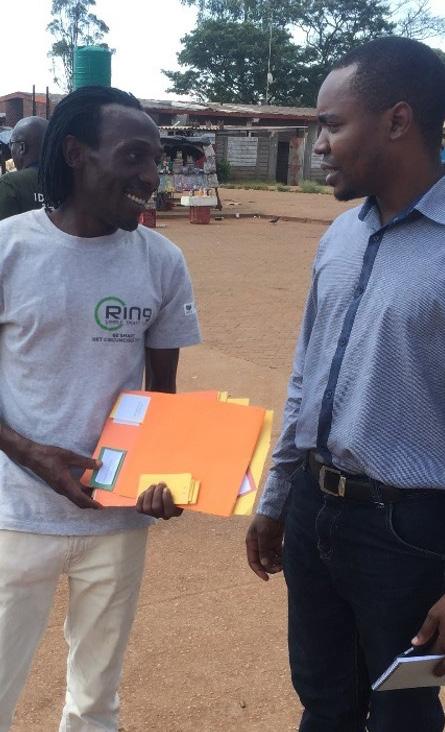
7 minute read
IMPROVING HEALTH CALLS FOR A PERSONALIZED APPROACH
Behavior change is hard. Everyone knows that exercise is good for you, but knowledge alone won’t turn most of us into runners or gym-goers. Even if we have time for exercise, or the money for a gym membership, there are other barriers to staying healthy. Advertisers promote unhealthy food and drink more than products that foster a healthy lifestyle; social norms may discourage exercise; family and friends may not support our goals. Above all, we’re often inhibited by a mixture of our beliefs, values, and emotions. How seriously do we take the risks of not exercising? How do we feel about our body? How can we weigh short-term pain against long-term gain?
If it’s hard for one person to adopt a healthy behavior, imagine the challenge facing public-health programs as they try to persuade millions of people to take steps to safeguard their health. This publication describes how the problem was addressed for an urgent and particularly difficult issue: persuading men to be circumcised to substantially reduce their risk of contracting HIV via heterosexual sex. The approach taken to tackle this challenge has applications far beyond this one intervention or disease.
Advertisement
The voluntary medical male circumcision (VMMC) program in eastern and southern Africa had ambitious goals and reached substantial scale, but its approach to messaging wasn’t changing the minds of men most at risk of HIV. So the Bill & Melinda Gates Foundation funded and collaborated with a consortium of partners, under the leadership and guidance of the governments of Zambia and Zimbabwe, to implement a new approach to generating demand for VMMC.
Faced with a complex problem, we applied a unique approach. We put men’s perspectives at the center of the program, creating a framework for understanding behavior that mapped their changing needs, beliefs, emotions, and values as they weighed the decision to be circumcised. Combining this human-centered framework with dataanalysis techniques adapted from private-sector advertising, we developed tools for community mobilizers to identify persuadable men and target them with messages designed specifically for them – similar to an advertiser who knows that an exercise program must be sold differently to different consumers, depending on whether they’re motivated by looks, lifestyle, or longevity. These tools were field-tested and refined, and then piloted as new interventions to generate demand for VMMC.
The initial results were not fully what we anticipated – in a programmatic evaluation in Zambia, the interventions increased the effectiveness of outreach, but in Zimbabwe, where we conducted a randomized controlled trial, the interventions appeared not to have a significant impact on demand. The difference in effect between the two countries may be because the interventions in Zimbabwe did not address an adequate range of clients’ needs, there were challenges in implementing and adhering to the study, and the study design itself made implementation less responsive to challenges on the ground. However, programmatic data from Zimbabwe does seem to show that the interventions there had a positive correlative effect upon VMMC uptake.
EVALUATION RESULTS
ZAMBIA A programmatic evaluation showed that 23 community mobilizers using the new interventions were able to book an average of 301 clients each for VMMC, compared to an average of 212 clients booked by each of the 54 mobilizers using the standard approach. This was a 42% increase in efficiency. In addition, 91% of those actually circumcised via the new interventions belonged to the 15-29-year age group that was being targeted in Zambia, compared to 50% of those circumcised using the standard approach.
ZIMBABWE We conducted a randomized controlled trial with four arms:

•Standard” community mobilization approach • Standard approach plus offer of HIV self-testing • The new approach • New approach plus offer of HIV self-testing The new approach showed no statistically significant effect upon the rate of VMMC uptake generated by community mobilizers. Offering HIV self-testing also showed no significant effect upon VMMC uptake per community mobilizer.
These results are described in more detail on pp. 47-57
The interventions evaluated represent just a few of the possible tools that can be generated using this behavioral framework and a human-centered design approach. The framework and approach are designed to be adaptable in other countries (Figure 1), and they’re being taken up across eastern and southern Africa. Understanding the target audience in depth and designing programs around the “client” can help resource-constrained public-health programs operate more effectively and efficiently. The projects in Zambia and Zimbabwe were the first to show the potential impact of our behavioral model in generating demand for VMMC. Simply put, it can help deliver a better program design. We believe it can inspire problemsolving in sectors beyond HIV prevention, and our experience holds lessons for other programs facing similar challenges.
Complex health challenges and the respective interventions to address these challenges generally require a multidisciplinary set of approaches and expertise. A creative, effective, and rigorous process brings people’s needs to the forefront when decisions are made about the design and implementation of interventions intended to bring about positive changes in their lives.” “
DESIGNFORHEALTH.COM
FIGURE 1: A SYSTEMATIC APPROACH TO EFFECTIVE PROGRAM DESIGN
FRAME THE CHALLENGE Frame existing evidence through the lens of behavior to focus the project effort 1
ESTABLISH QUALITATIVE FRAMEWORK Understand the target population in depth to define behavior framework 2
QUANTITATIVE RESEARCH AND SEGMENTATION Quantify barriers to behavior change and divide population into actionable segments 3
BEHAVIOR FRAMEWORK Establish the final framework and identify the highest-impact areas of focus 4
CREATE TOOLS TO ACT Create organizational tools that leverage the framework to empower planning/design 5
DEVELOP PORTFOLIO OF INTERVENTIONS Design holistic solutions for the key barriers to enable behavior change 6
EVALUATE AND ITERATE Prototype, measure, and learn to refine the interventions 7
EXTEND THE IMPACT Deploy the framework and tools in other countries and contexts 8
THIS APPROACH IS DESIGNED TO BE FLEXIBLE, AND SOME STEPS (SUCH AS SEGMENTATION) ARE NOT ESSENTIAL WHERE RESOURCES ARE LIMITED
The HIV epidemic and potential for impact with VMMC
In 2017, an estimated 19.6 million people were living with
HIV in eastern and southern Africa, and 380,000 people
died of HIV-related illnesses. The same year, around 800,000
people became infected with HIV in the region – nearly half
of all new HIV infections globally. 1 Preventing the spread of
HIV remains an urgent humanitarian and economic need. It’s also a challenge for countries in the region, many of which have rapidly growing populations – meaning that more people become sexually active each year – and face significant resource constraints upon their health systems.
More than 90% of HIV infections in the region are transmitted
through heterosexual sex. Research in three African countries
in the early 2000s showed that being circumcised reduces a
man’s risk of acquiring HIV through sex with an HIV-positive
woman by 60%. 2,3,4 In response, the World Health Organization
and the Joint United Nations Programme on HIV/AIDS (UNAIDS)
recommended voluntary medical male circumcision as a key
intervention for preventing HIV. 5 The VMMC program focuses
on 14 countries in eastern and southern Africa with high rates of HIV and low rates of circumcision in men.
The potential gains for those countries were significant: research
showed that raising the circumcision rate to above 80% among
males aged 15-49 by 2015 (and maintaining it at that level
by circumcising boys as they entered this age group) could
avert 3.4 million new HIV infections over a 10-year period. 6
The VMMC program focused on rapidly scaling up high-quality
services and communicating the safety and preventive benefits
to attract prospective clients. By the end of 2017, a cumulative
18.6 million circumcisions had been performed. 7 Despite this
impressive progress, there had been periods of flagging demand, particularly among those at highest risk of HIV. Meanwhile, UNAIDS had made its targets even more ambitious, calling for an additional 25 million circumcisions between 2016 and 2021.
With most “early adopters” – those men most easily persuaded to undergo circumcision – already circumcised, the challenge now was to find new approaches to persuade those who were more resistant to the idea, and those who were likely at higher risk of HIV. The need was urgent if UNAIDS’ ambitious goal was to be met: to eliminate HIV as a global threat by 2030.
Why Zambia & Zimbabwe?
Zambia and Zimbabwe are two of the
priority countries participating in the VMMC
program. They are hard hit by HIV: in 2016,
HIV prevalence among males was 12.3% in
Zambia and 10.5% in Zimbabwe, and between
them the two countries accounted for 100,000
new infections that year. 8 By the end of 2017,
Zambia had performed almost 2 million
VMMCs, and Zimbabwe 1.1 million, 7 but under
the new UNAIDS goals, their targets for 2024 had doubled. New interventions were needed to generate more demand for VMMC.
The 14 priority countries Botswana, Ethiopia, Kenya, Lesotho, Malawi, Mozambique, Namibia, Rwanda, South Africa, Swaziland, Tanzania, Uganda, Zambia, Zimbabwe






